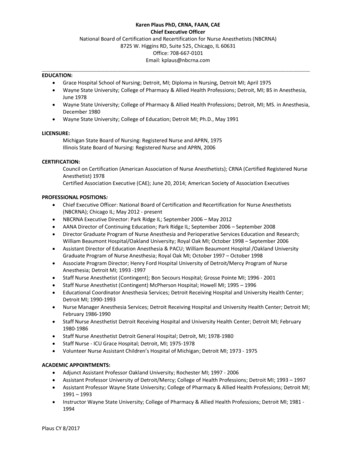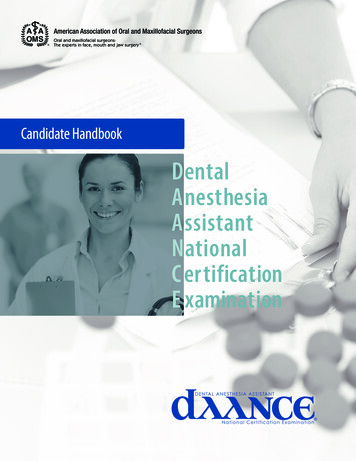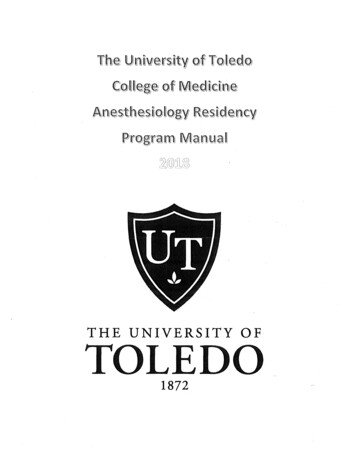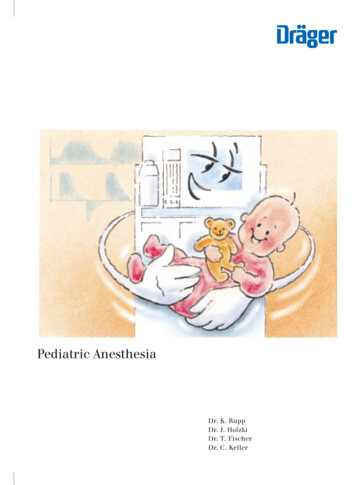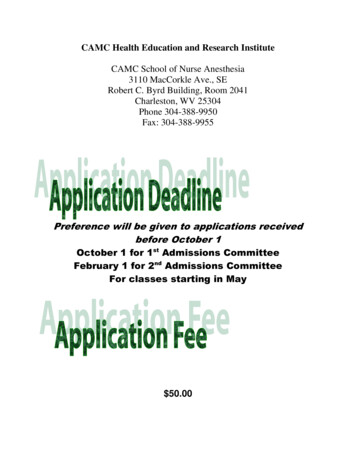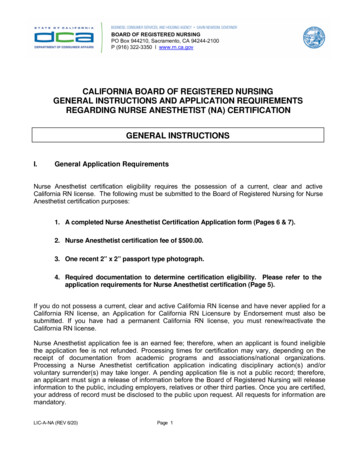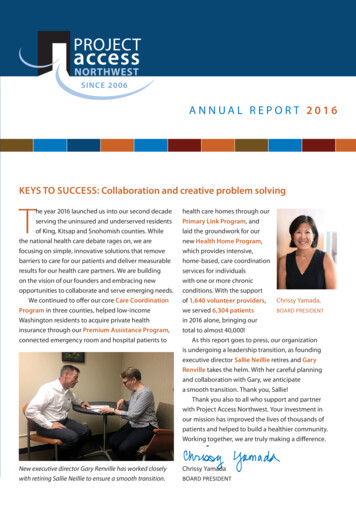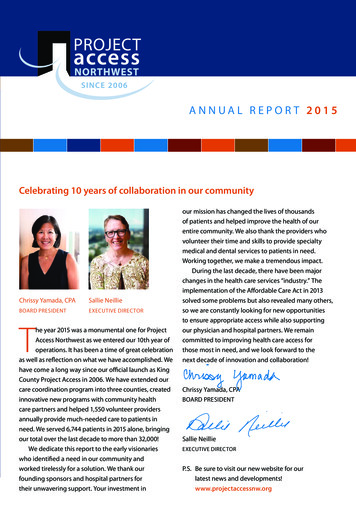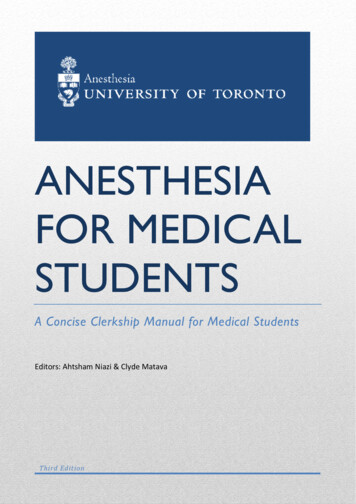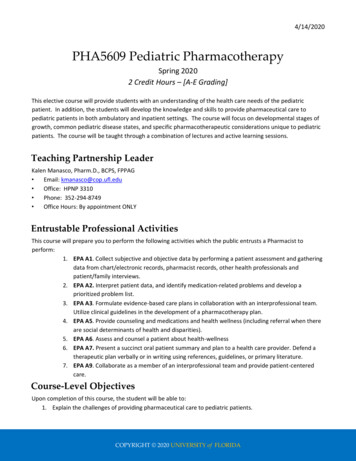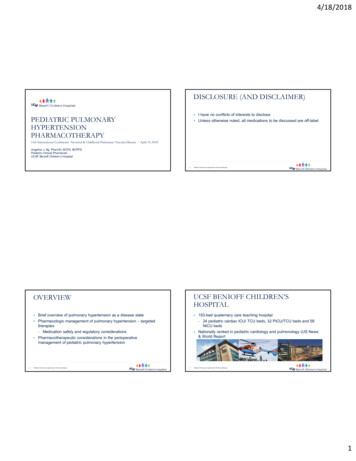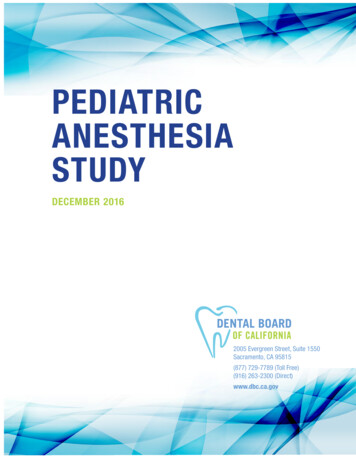
Transcription
PEDIATRICANESTHESIASTUDYDECEMBER 20162005 Evergreen Street, Suite 1550Sacramento, CA 95815(877) 729-7789 (Toll Free)(916) 263-2300 (Direct)www.dbc.ca.gov
MEMBERS OF THE DENTAL BOARD OF CALIFORNIASteven Morrow, DDS, MS, PresidentJudith Forsythe, RDA, Vice PresidentSteven Afriat, SecretaryFran Burton, MSWSteven Chan, DDSYvette Chappell-IngramKatie Dawson, BS RDHAPKathleen KingRoss Lai, DDSHuong Le, DDS, MAMeredith McKenzie, ESQ.Thomas Stewart, DDSBruce L. Whitcher, DDSDebra Woo, DDS, MAEdmund G. Brown, Jr., GovernorAlexis Podesta, Acting Secretary, Business Consumer Services, and Housing AgencyAwet Kidane, Director, Department of Consumer AffairsKaren Fischer, MPA, Executive Officer, Dental Board of California
PEDIATRIC ANESTHESIA STUDYTABLE OF CONTENTSExecutive Summary . . . . . . . . . . . . . . . . . . . . . . . . . . . . . . . 1Introduction . . . . . . . . . . . . . . . . . . . . . . . . . . . . . . . . . . . 2Background . . . . . . . . . . . . . . . . . . . . . . . . . . . . . . . . . . . 2Definitions Used in Dental Sedation and Anesthesia . . . . . . . . . . . . . . 5Dental Board General Anesthesia, Conscious Sedationand Oral Conscious Sedation Permit Programs . . . . . . . . . . . . . . . . . 7PART 1:The Present Laws, Regulations, and Policies in California,and a Comparison of These Laws, Regulations and Policiesto Those of Other States and Dental Associations . . . . . . . . . . . . . . . 8Current California Sedation and Anesthesia Laws. . . . . . . . . . . . . . . . .Dental Sedation and Anesthesia Laws in Other States . . . . . . . . . . . . . .Comparison of California Laws With Laws in Other States . . . . . . . . . . . .Advanced Educational Programs that Include Sedation Training . . . . . . . . .Summary of Comparison of California Laws and Regulations to Other States. . .Discussion of Differences . . . . . . . . . . . . . . . . . . . . . . . . . . . . .Professional Dental Association Guidelines, Position Papersand Policy Statements . . . . . . . . . . . . . . . . . . . . . . . . . . . . . .Discussion of Differences and Similarities Between California Laws and the ADA .8.910131920. . . . . . . . . 21. . . . . . . . . 28Summary of Differences and Similarities Between California Laws and the AADAand AAP-AAPD Guidelines . . . . . . . . . . . . . . . . . . . . . . . . . . . . . . . . . . . . . 29Discussion of Areas Where California Requirements are Different FromProfessional Guidance Documents . . . . . . . . . . . . . . . . . . . . . . . . . . . . . . . . . 29PART 2:Literature Review - Sedation and General Anesthesiafor Pediatric Dental Patients . . . . . . . . . . . . . . . . . . . . . . . . . . 33Dental Sedation and Anesthesia Outcomes Reports . . . . . . . . . . . . . . . . . . . . . . . . 47Summary of Literature Review . . . . . . . . . . . . . . . . . . . . . . . . . . . . . . . . . . . 46PART 3:Dental Board of California - Data Related to PediatricSedation and Anesthesia. . . . . . . . . . . . . . . . . . . . . . . . . . . . 49Notification of Pediatric Deaths . . . . . . . . . . . . . . . . . . . . . . . . . . . . . . . . . . . 49Appendix 1 . . . . . . . . . . . . . . . . . . . . . . . . . . . . . . . . . . . 57Appendix 2 . . . . . . . . . . . . . . . . . . . . . . . . . . . . . . . . . . . 67
Dental Board Pediatric Anesthesia StudyEXECUTIVE SUMMARYThis document is prepared in response to Senator Jerry Hill’s February 8, 2016, letterrequesting a subcommittee investigation of California’s present laws, regulations and policiesrelated to pediatric dental anesthesia, whether or not they are sufficient to guard againstunnecessary use of general anesthesia in the treatment of pediatric patients, and whetherthese laws assure patient safety.California dental sedation and anesthesia laws are similar to laws in other states, and differprimarily in the area of personnel requirements. Approximately half of other states specify thenumber of staff who must be present, in addition to the dentist, when general anesthesia ormoderate sedation is administered. No state requires the presence of an individual dedicatedto both the monitoring and administration of general anesthesia or moderate sedation.California policies, laws and regulations are generally consistent with professional dentalassociation guidelines with the exception of a recommendation in the American Academy ofPediatrics-American Academy of Pediatric Dentistry Guidelines for a person dedicated to themonitoring and administration of deep sedation and general anesthesia.A review of the relevant medical and dental literature revealed that, although serious adverseevents related to dental sedation and anesthesia are rare, there are few if any high qualitystudies of pediatric dental sedation. Available data do not reveal an association betweenadverse outcomes and the type of provider or practice model.The Dental Board’s (Board) enforcement staff prepared data from mandatory reports ofdeath/hospitalization (BPC 1680z) for patients under age 21 received between January 1, 2010and December 31, 2015. The data for this six-year period revealed that death or serious injuryassociated with sedation and anesthesia for dental treatment are extremely rare, including onlytwo patients who died in association with oral sedation, and one patient who died inassociation with a general anesthetic administered in a dental office. The Board estimates thatapproximately 133,000 patients under age 21 receive sedation or general anesthesia each yearin conjunction with dental treatment.The Board recommends updating terminology, staffing requirements, educationalrequirements, and monitoring standards in an effort to improve the safety of pediatric dentalanesthesia and sedation.The Board recognizes that the manpower and economic considerations for pediatric dentalsedation are beyond the scope of the present report. These considerations will be critical to thesuccessful implementation of any changes to dental sedation laws. The Board thereforerecommends that there be an analysis of the effects of any proposed new legislation orregulation on access to care for pediatric dental patients prior to the implementation of anychanges.1
Dental Board of California Pediatric Sedation StudyINTRODUCTIONIn February 2016, Senator Jerry Hill, Chair of the Senate Committee on Business, Professions,and Economic Development, was made aware of a tragedy in which an otherwise healthy childdied after receiving general anesthesia at a dentist’s office. He notified the Dental Board ofCalifornia (Board) of his concern about the rise in the use of anesthesia for young patients andasked the Board to investigate whether California’s present laws, regulations, and policies aresufficient to protect the public. In doing the research, Senator Hill asked the Board to review allincident reports collected by the Board related to pediatric anesthesia in California for the pastfive years.The Board President appointed a two-person subcommittee to work with staff to research thisissue; the study was expanded to include review of incident reports related to all levels ofpediatric sedation including conscious sedation, oral conscious sedation, and generalanesthesia as well as administration of local anesthetic in California for the past six years (20102015).This report reflects three parts of the study: (1) the present laws, regulations, and policies inCalifornia and a comparison of these laws, regulations and policies to those of other states anddental associations, (2) review of relevant dental and medical literature, and (3) review of allincident reports in California for patients 21 years of age.BACKGROUNDHistory of Anesthesia and the Scope of Practice of DentistryAlthough both dentists and physicians contributed to early developments in the field ofanesthesiology, each profession evolved differently. Advances in medical anesthesiologyevolved slowly until 1923 when a few physicians had the novel idea of creating a separatedepartment of anesthesia in medical schools. This advance allowed all teaching, training, andresearch endeavors to be organized and supervised by one department head. This marked thebeginning of medical anesthesiology as a scientific discipline.The practice of anesthesiology in dentistry took a different path, with dentists practicing variousforms of anesthesia as a technique taught by practitioners to one another. This approach didnot initially provide an environment for formal research. Anesthesia techniques developedspecifically for dentistry became more widely accepted by the profession in the middle of the20th century. Drs. Morgan Allison, Adrian Hubbell, Leonard Monheim and others first utilized2
new techniques and new anesthetics that became available at the time. Other dentistsdeveloped what was then a new technique, termed “conscious sedation” which utilized subanesthetic doses of general anesthetic drugs along with local anesthesia. These new anesthesiaconcepts and ideas led to the establishment of the American Dental Society of Anesthesiology(ADSA) in 1953. Among the chief goals of these pioneer dentists was to provide education inadvanced pain and anxiety control for all dentists.Case law has clarified the place of anesthesia within the scope of dental practice. The courtsthat have reviewed anesthesia scope of practice cases have consistently viewed anesthesiologyas being within the scope of practice of dentistry as well as other health care disciplines.However, the courts have ruled that individual providers are limited to their scope of practiceas defined by state law. Anesthesia should therefore be administered according to the statutesand regulations that each state uses to govern an individual’s core license to practice. 1History and Function of the Dental Board of CaliforniaThe California Legislature created the Dental Board of California (Board) in 1885 to regulate thepractice of dentistry. Today, the Board regulates approximately 86,000 licensed dentalhealthcare professionals in California, including approximately 40,000 dentists, 44,000registered dental assistants (RDAs) and 1,500 registered dental assistants in extended functions(RDAEFs). In addition, the Board is responsible for setting the duties and functions ofapproximately 50,000 unlicensed dental assistants. The Board's last sunset review was in 2015.The practice of dentistry is defined in Business and Professions Code Section 1625 as:“The diagnosis or treatment, by surgery or other method, of diseases and lesions and thecorrection of malpositions of the human teeth, alveolar process, gums, jaws, or associatedstructures; and such diagnosis or treatment may include all necessary related procedures as wellas the use of drugs, anesthetic agents, and physical evaluation.”The Board meets at least four times throughout the year to address work completed by thevarious committees, and, as noticed on the agenda, may meet in closed session as authorizedby Government Code Section 11126 et. seq.1Boynes, S.G., A Guide to Dental Anesthesiology Rules and Regulations, 5th ed., Chicago, No-No Orchard Publishing,2013. 939/Fifth Edition Dental Anesthesiology Guide to the Rules and Regulations.pdf3
The mission of the Board is defined in Business and Professions Code Section 1601.2, whichstates:“Protection of the public shall be the highest priority for the Dental Board of California inexercising its licensing, regulatory, and disciplinary functions. Whenever the protection of thepublic is inconsistent with other interests sought to be promoted, the protection of the publicshall be paramount.”To meet its obligations, the Board implements regulatory programs and performs a variety offunctions. These programs and activities include setting licensure requirements for dentists anddental assistants, including examination requirements, and issuing and renewing licenses,including a variety of permits and certifications. The Board also has its own enforcementdivision, with sworn and non-sworn staff, which is tasked with investigating both criminal andadministrative violations of the Dental Practice Act (Act) and other laws. As part of thedisciplinary function of the Board, it also monitors dentists and RDAs who may be on probation,and manages a Diversion Program for licensees whose practice may be impaired due to abuseof dangerous drugs or alcohol.Board Membership and CommitteesThe Board is composed of 15 members: eight practicing dentists, one registered dentalhygienist (RDH), one RDA, and five public members, which account for one-third of themembership. The Governor appoints the dentists, the RDH, the RDA, and three publicmembers. The Speaker of the Assembly and the Senate Rules Committee each appoint onepublic member. Of the eight practicing dentists, one must be a member of the faculty of anyCalifornia dental school, and one is required to be a dentist practicing in a nonprofit communityclinic. Members of the Board are appointed for a term of four years, and each member mayserve no more than two full terms.Purpose of State LawsState laws and regulations are general rules governing people's rights or conduct. Laws andregulations do not contain recommendations, model procedures, lists of resources, orinformation about practice or procedures, otherwise known as guidance documents.Laws are developed following a legislative plan that includes an analysis of the existing law, ananalysis of the necessity of legislation, a statement that no other regulatory choice would beeffective; analysis of potential danger areas (constitutional, legal, practical); and an analysis ofthe practical implications of the legislative proposal. Regulations are developed to implement,interpret, and make specific the law. Statutes and regulations are, of necessity, concise and inthe case of dental laws, establish the minimum standards for the safe practice of dentistry.4
Laws and regulations are usually applied literally and can limit the ability of the licensee toexercise discretion.Dental Board Enforcement UnitThe Board utilizes its disciplinary process to enforce the Dental Practice Act. The Board hasbroad authority over its licensees and may issue administrative citations, impose fines, andreprimand, revoke, suspend, or place conditions upon a dental license. All complaints against alicensee are reviewed and if there is sufficient evidence of professional misconduct anaccusation is filed.Accusations may be based on specific acts or omissions of those duties described in the PracticeAct, or as established by expert testimony of gross negligence or incompetence sufficient torequire discipline. This provision makes it unnecessary to state every conceivable practicestandard, as to do so would clearly be impractical.DEFINITIONS USED IN DENTAL SEDATION AND ANESTHESIAThe American Society of Anesthesiology developed new definitions of levels of sedation in1999. These definitions were subsequently adopted by most other organizations involved in theprovision of sedation and anesthesia care. The Dental Board first suggested adoption of thesedefinitions into its laws in 2005 and again in 2010.Appendix 2 Table 1 includes a side-by-side comparison of California’s current definitions of oralconscious sedation, parenteral conscious sedation, and general anesthesia with contemporarydefinitions. analgesia – the diminution or elimination of pain. anxiolysis – the diminution or elimination of anxiety. conscious sedation – a minimally depressed level of consciousness that retains thepatient’s ability to independently and continuously maintain an airway and respondappropriately to physical stimulation or verbal command and that is produced by apharmacological or non-pharmacological method or a combination thereof. deep sedation – a drug-induced depression of consciousness during which patientscannot be easily aroused, but respond purposefully after repeated verbal or painfulstimulation. Patients may require assistance in maintaining a patent airway, andspontaneous ventilation may be inadequate. Cardiovascular function is usuallymaintained. A state of deep sedation may be accompanied by partial or complete lossof protective airway reflexes. Patients may readily pass from a state of deep sedationto the state of general anesthesia.5
enteral – any technique of administration in which the agent is absorbed through thegastrointestinal (GI) tract or oral mucosa. general anesthesia – a drug-induced loss of consciousness during which patients arenot arousable, even by painful stimulation. The ability to independently maintainventilation is often impaired. Patients often require assistance in maintaining apatent airway, and positive-pressure ventilation may be required. Cardiovascularfunctionmaybeimpaired. incremental dosing – administration of multiple doses of a drug until a desired effect isreached, but not to exceed the maximum recommended dose (MRD). inhalation – a technique of administration in which a gaseous or volatile agent isintroduced into the lungs and whose primary effect is due to absorption through thegas/blood interface. local anesthesia – the elimination of sensation, especially pain, in one part of the bodyby the topical application or regional injection of a drug. maximum recommended dose (MRD) – maximum FDA-recommended dose of a drug, asprinted in FDA-approved labeling for unmonitored home use. minimal sedation – a drug-induced state during which patients respond normally toverbal commands. Although cognitive function and coordination may be impaired,breathing and cardiovascular functions are unaffected. In accord with this particulardefinition, the drug(s) and/or techniques used should carry a margin of safety wideenough never to render unintended loss of consciousness. Further, patients whose onlyresponse is reflex withdrawal from repeated painful stimuli would not be considered tobe in a state of minimal sedation. moderate sedation – a drug-induced depression of consciousness during whichpatients respond purposefully to verbal commands or after light tactilestimulation. No interventions are required to maintain a patent airway, andspontaneous ventilation is adequate. Cardiovascular function is usuallymaintained. parenteral – a technique of administration in which the drug bypasses thegastrointestinal tract. recovery – the ability to regain full health, or a return to baseline status. supplemental dosing – during minimal sedation, supplemental dosing is a singleadditional dose of the initial dose of the initial drug that may be necessary for prolongedprocedures. titration – the administration of small incremental doses of a drug until a desired clinicaleffect is observed.6
transdermal – a technique of administration in which the drug is administered by patchor iontophoresis through skin. transmucosal – a technique of administration in which the drug is administered acrossmucosa such as intranasal, sublingual, or rectal.DENTAL BOARD GENERAL ANESTHESIA, CONSCIOUS SEDATION AND ORAL CONSCIOUSSEDATION PERMIT PROGRAMSLegislative HistoryThe California Dental Practice Act regulates the use of sedation and general anesthesia byCalifornia dentists. These laws and regulations may be accessed through the Dental Board ofCalifornia’s website. There is an annual publication of the California Dental Practice Act that isavailable from the legal and professional document publisher Lexis Nexis.The Board has long sought to improve the safety of sedation and anesthesia in California,working with the California Dental Association to co-sponsor Senate Bill 386 (Keene, 1979), thefirst legislation to regulate the use of general anesthesia by dentists in California. This billincluded a requirement for mandatory office inspections that were based on a voluntaryprogram originally developed by Southern California oral surgeons. Conscious sedation laws, AB1276 (Tucker, 1986) also sponsored by the Board and CDA, followed as did Assembly Bill 2006(Keeley, 1998) and AB 1386 (Laird, 2005), the most recent update of sedation laws. These lawswere sponsored as proactive measures to improve patient safety. An exception was AB 564(Keene, 2001), a bill that established reporting requirements for patient deaths, that wasintroduced at the request of a mother whose son suffered brain damage after he was givenchloral hydrate, an oral sedative, by his dentist.In 2002, the Board called for a review of anesthesia laws and patient outcomes to see if anyimprovements could be made to the existing regulatory program. To accomplish this goal theBoard appointed the Blue Ribbon Panel on Anesthesia (Panel), an ad hoc committee composedof general dentists and dental specialists who were recognized experts in the field. The Panelreviewed laws in other states, dental association guidelines, death statistics provided by theBoard, and closed claims from an insurance carrier, as well as current laws.The Panel’s recommendations were approved by the Board and ultimately enacted throughstatute and regulation beginning in 2006. 2 There is no record of any significant opposition tothe recommended changes which included the addition of an adult oral conscious sedationpermit, new requirements for pre-anesthetic physical evaluation of patients, and improvements2Dental Board of California: Recommendations of the Blue Ribbon Panel, November 7, 2003.7
to the office inspection program. The Panel did not recommend that a specific number ofpersonnel be present, nor was there any recommendation for staff training other than basicCPR. There was no recommendation for pre-operative dietary instructions due to controversyabout appropriate requirements. At the time, the Board was aware of the need to updateanesthesia terminology to achieve consistency with new definitions adopted by the AmericanDental Association, but chose to defer this until a later date, and recommended that thesechanges be made during sunset review.In 2010, the Board president appointed a subcommittee to study the definitions to makerecommendations for their adoption and to review the relevant statues and regulation forcurrency. The 2010 subcommittee recommended that the anesthesia and sedation laws bereviewed and updated every five years and suggested strategies for accomplishing this task.Once statues were amended, other changes could be implemented by regulation. A series ofinformal stakeholder meetings followed and the subcommittee submitted a legislative proposalto the Board in November 2013. This item was noticed for discussion and possible action at theNovember 22, 2013 meeting. The California Society of Pediatric Dentists stated support butprovided no specific comments. The proposal was identified as a future Board priority.PART 1: THE PRESENT LAWS, REGULATIONS, AND POLICIES IN CALIFORNIA; AND ACOMPARISON OF THESE LAWS, REGULATIONS AND POLICIES TO THOSE OF OTHER STATESAND DENTAL ASSOCIATIONSCURRENT CALIFORNIA SEDATION AND ANESTHESIA LAWSA summary of California’s current dental sedation and anesthesia laws is provided in theattached Appendix 2, Tables 2-8. California Business and Professions Code (BPC) Sections 1646and 1647 describe educational qualifications and other requirements necessary for a dentist tobecome eligible for a permit to administer general anesthesia or sedation. These laws include arequirement for general anesthesia and conscious sedation permit holders to undergo an officeinspection every 5-6 years; completion of continuing education every 2 years; a list of violationsthat are considered unprofessional conduct; and requirements for a physician and surgeon toobtain a permit to administer general anesthesia in a dental office. BPC Sections 1680 and 1682describe acts that constitute unprofessional conduct specifically related to sedation andanesthesia.BPC Section 1647 addresses conscious sedation and includes the statement that “the drugs andtechniques used shall have a margin of safety wide enough to render unintended loss ofconsciousness unlikely.” This broad approach to limiting the use of potent sedatives recognizesthat almost any drug or combination of drugs, when used in sufficient quantity, can produce8
loss of consciousness, particularly in the very young, very old, and medically compromisedpatients.The duties of dental assistants are described in BPC Section 1750, and includes patientmonitoring and other sedation related duties they may perform. California Code of Regulations(CCR) Section 1070 specifies the educational course and program approval process for dentalassistants, including the Dental Sedation Assistant.CCR Sections 1043 and 1044 provide requirements for supervision of sedated patients,definitions of levels of sedation, and additional details of permit requirements. CCR Section1043 provides the details of the office inspection program, including composition of theinspection team, office facility requirements, equipment requirements, including patientmonitors, preoperative evaluation, records, emergency drugs, conduct of the evaluationincluding a demonstration of general anesthesia and performance of the 13 simulatedemergencies, and administrative procedures for the office evaluation process. The Boardpresently issues the following permits:1.2.3.4.5.Pediatric oral conscious sedationAdult oral conscious sedationParenteral conscious sedationGeneral anesthesiaPhysician anesthesiologist dental anesthesiaDENTAL SEDATION AND ANESTHESIA LAWS IN OTHER STATESCompilations of dental sedation and anesthesia laws for all 50 states are available from theAmerican Dental Association, 3 4 the American Dental Society of Anesthesia 5 and the AmericanAssociation of Oral and Maxillofacial Surgeons. 6 These publications provide summaries of alllaws and regulations relevant to general anesthesia and deep sedation as well as moderate and3American Dental Association, “Statutory Requirements for General Anesthesia and Deep Sedation Permits,” 2009.http://www.ada.org/en/ /media/ADA/Advocacy/Files/anesthesia general permit4American Dental Association, “Statutory Requirements for General Anesthesia and Deep Sedation Permits,” 2009.http://www.ada.org/en/ /media/ADA/Advocacy/Files/anesthesia sedation permit5Boynes, S.G., A Guide to Dental Anesthesiology Rules and Regulations, 5th ed., Chicago, No-No Orchard b0p8rhh9imk4939/Fifth Edition Dental Anesthesiology Guide to theRules and Regulations.pdf6American Association of Oral and Maxillofacial Surgeons, State Requirements for General Anesthesia Delivery –Summary, Rosemont, IL, updated 4/19/2016.9
minimal sedation in all 50 states. The Board obtained additional information related to minimaland moderate enteral sedation laws from the Dental Organization for Conscious Sedation(DOCS Education). 7 The Canadian provinces have adopted the American model for dentalsedation and anesthesia and utilize a similar regulatory framework. The subcommittee did notreview provincial laws for this report.Laws in California and most other states reference guidelines published by the American DentalAssociation 8 9 and the educational standards of the Commission on Dental Accreditation of theAmerican Dental Association, 10 and frequently incorporate some but not all of therecommendations included in these guidance documents.COMPARISON OF CALIFORNIA LAWS WITH LAWS IN OTHER STATESMethodsThe subcommittee summarized information from compilations of state laws for this report.Where information was incomplete or missing, the practice act for that state was downloadedfrom the state board website and reviewed for relevant sections. If necessary, the individualdental board was contacted to obtain additional information. For some states there werequestions that required legal interpretation that could not be completely resolved. Texas, SouthCarolina, and Alaska have rulemaking in progress so their existing rules were reviewed.Certain state laws and regulations were relatively uniform across all 50 states. Other state lawswere less consistent.The subcommittee made every effort to verify the accuracy of information presented, howeverdue to the variability, complexity, and ever changing nature of state laws and regulations thisreport may include some inaccuracies. The Board welcomes the opportunity to provideadditions or corrections to this information.7DOCS Education http://www.sedationregulations.com/8American Dental Association. (2012). “Guidelines for the Use of Sedation and General Anesthesia by Dentists”. InSociety (Vol. 80, pp. 75–106). .ada.org/en/ /media/ADA/Advocacy/Files/anesthesia use guidelines9American Dental Association. (2012). “Guidelines for Teaching Pain Control and Sedation to Dentists and DentalStudents”. In ADA (Ed.), (pp. 1–18). Chicago. Retrieved from: http://www.ada.org/en/ /media/ADA/MemberCenter/Files/anxiety guidelines10Commission on Dental Accreditation: (2012). “Accreditation Standards for Advanced Specialty EducationPrograms in Oral and Maxillofacial Surgery”. Retrieved fromhttps://www.ada.org/ /media/CODA/Files/oms.pdf?la en10
AREAS OF COMPARISONPermitting of Practice LocationsFor the majority of states, including California, the permit to administer sedation or generalanesthesia is assigned to the individual dentist and not to a facility. The California Dental Boardmaintains broad authority over its licensees and may conduct an inspection of any dentalfacility at its own discretion. Although the majority of states, including California, require aperiodic facility inspection, only a single facility utilized by the permit holder is usuallyinspected. The permit holder is assigned the responsibility for assuring that all facilities wheresedation is administered are appropriately equipped and staffed as required by law.The Board identified nine (9) states t
pediatric sedation including conscious sedation, oral conscious sedation, and general anesthesia as well as administration of local anesthetic in California for the past six years (2010-2015). This report reflects three parts of the study
